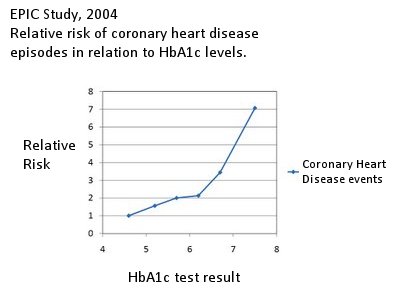HbA1c: What is it?
HbA1c is an acronym for a test which measures the amount of glycated, or “sticky” hemoglobin in your red blood cells over time.
Hemoglobin is a substance inside your red blood cells which acts as a carrier for oxygen from your lungs to all of the other cells in your body.
As you may know, sugar is very sticky, especially sugar in a liquid form. This is the form that is found in your blood stream, especially after you eat a high carbohydrate meal.
The sugar in your blood stream bonds (glycates) to the hemoglobin protein in your red blood cells, and makes this protein sticky. Since red blood cells live about 120 days, the test can "look backwards" and give you a picture of your average blood sugar levels over the preceding 2 to 3 months.
Simply put, the higher your average blood sugar, the more hemoglobin that becomes glycated, and the higher your hemoglobin a1c levels on the test results.
The general consensus in the medical community is that an HbA1c level below 6 is normal. Many doctors only perform this test if they suspect a diagnosis of diabetes. You may have to ask for it specifically.
However, the EPIC study results suggests that the lower the number resulting from this test, the better.
Why is it important to keep your blood sugar and hence your HbA1c levels low? Because studies like the EPIC Norfolk study have shown that a glycated hemoglobin level above 6 sharply increases your risk of a heart attack.
The EPIC study results state: "In men and women, the relationship between hemoglobin A1c and cardiovascular disease (806 events) and between hemoglobin A1c and all-cause mortality (521 deaths) was continuous and significant throughout the whole distribution. The relationship was apparent in persons without known diabetes. Persons with hemoglobin A1c concentrations less than 5% had the lowest rates of cardiovascular disease and mortality...these relative risks were independent of age, body mass index, waist-to-hip ratio, systolic blood pressure, serum cholesterol concentration, cigarette smoking, and history of cardiovascular disease."
If you plot the raw data from the EPIC study on a chart, as Peter at Hyperlipid did, it looks like this:

And another study published here, found that "in the overall population, higher levels of GHb (glycated hemoglobin)were associated with increased risk of mortality from all causes, heart disease, and cancer."
Pretty convincing reason to cut back on your carbohydrate intake, if you ask me. Keeping your carb intake low will automatically lower your average blood sugar, which in turn will lower your glycated hemoglobin levels.
Here's an article on Science Daily's website which explains why "Hemoglobin A1c outperforms fasting glucose for Diabetes risk prediction."
HbA1c Values
The table below provides a reference for HbA1c values and how they correlate to blood sugar levels. Normal ranges are noted.
| HbA1c | Glucose level (mg/dl) during prior 2-3 months |
| 4% | 60 (normal) |
| 5% | 90 (normal) |
| 6% | 120 (normal) |
| 7% | 150 |
| 8% | 180 |
| 9% | 210 |
| 10% | 240 |
| 11% | 270 |
| 12% | 300 |
| 13% | 330 |
| 14% | 360 |
All of my books are available in electronic PDF, and now in paperback on Amazon!
 |
 |
 |
|
Buy paperbook on Buy paperback on Amazon Buy the e-Book via Paypal |
Buy paperback on Buy paperback on Amazon Buy the e-Book via Paypal |
Buy paperback on Buy paperback on Amazon Buy the e-Book via PayPal |